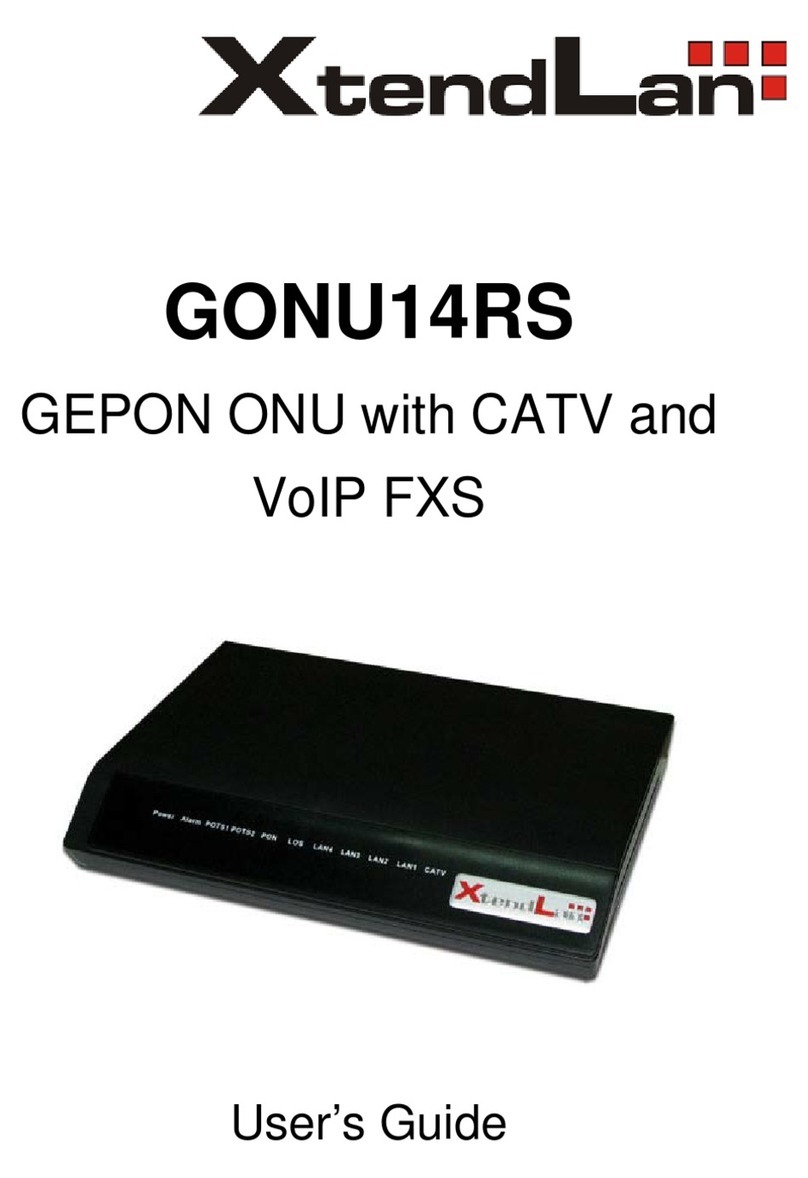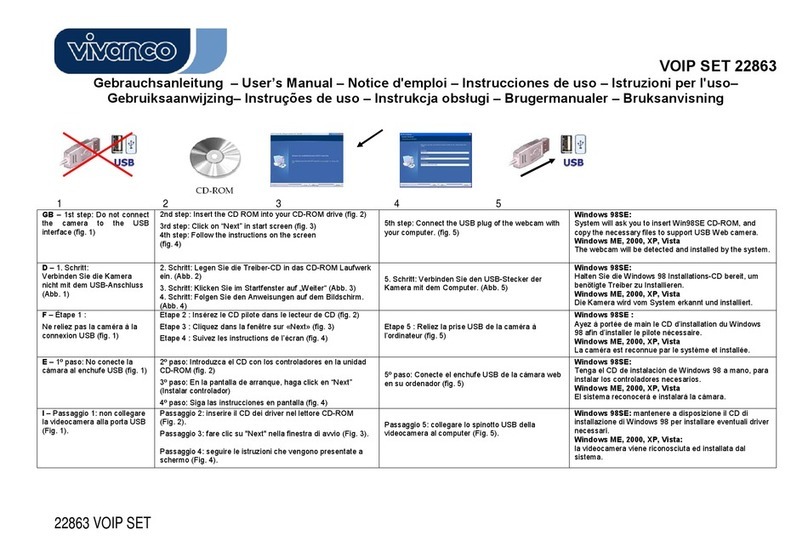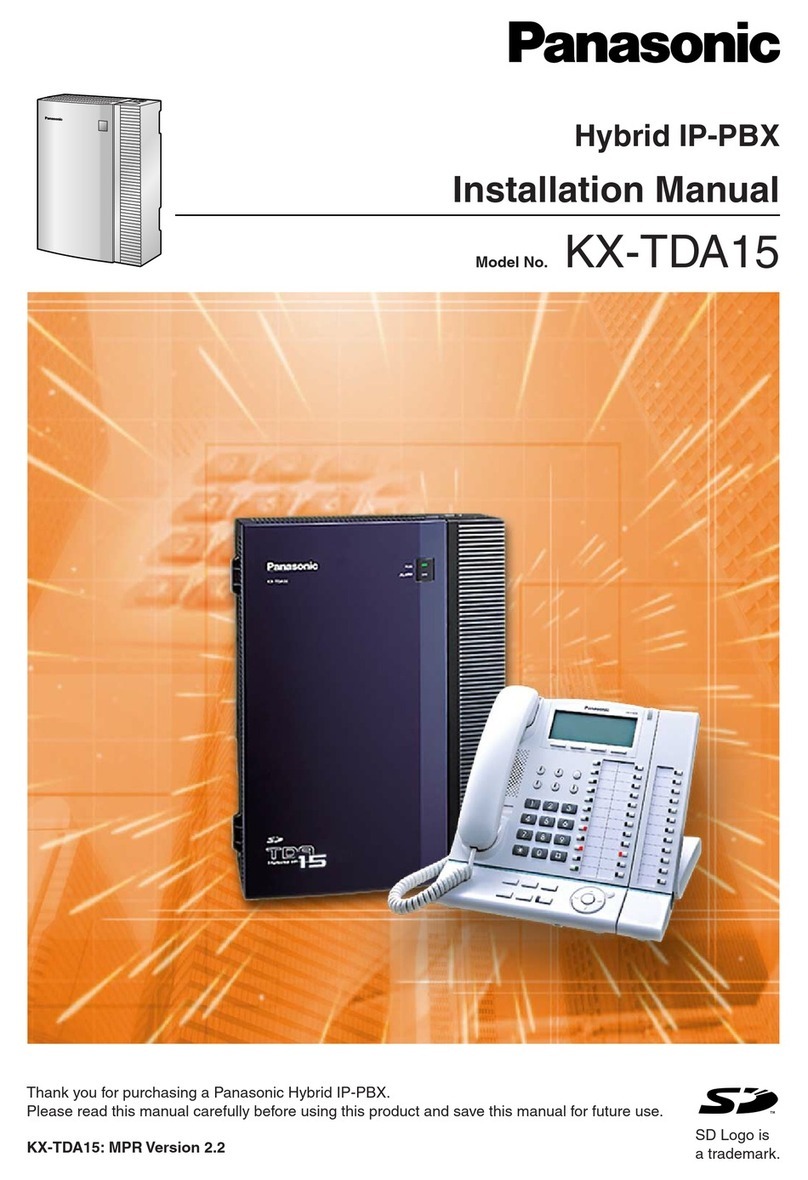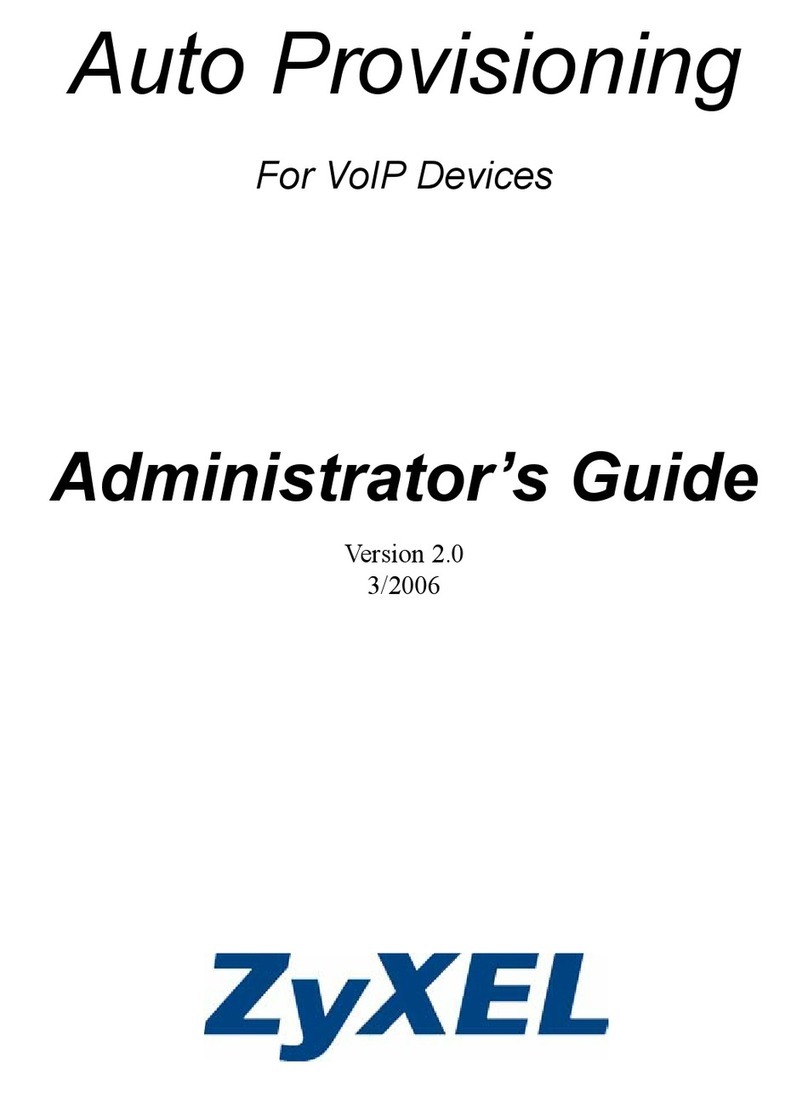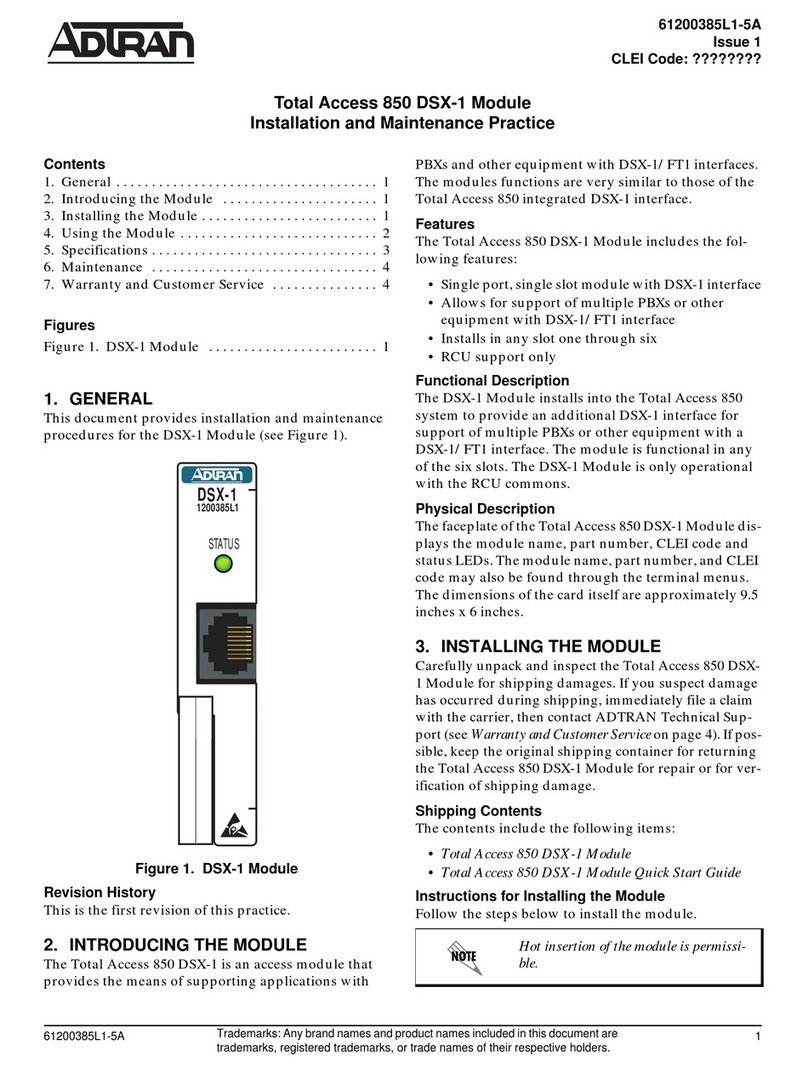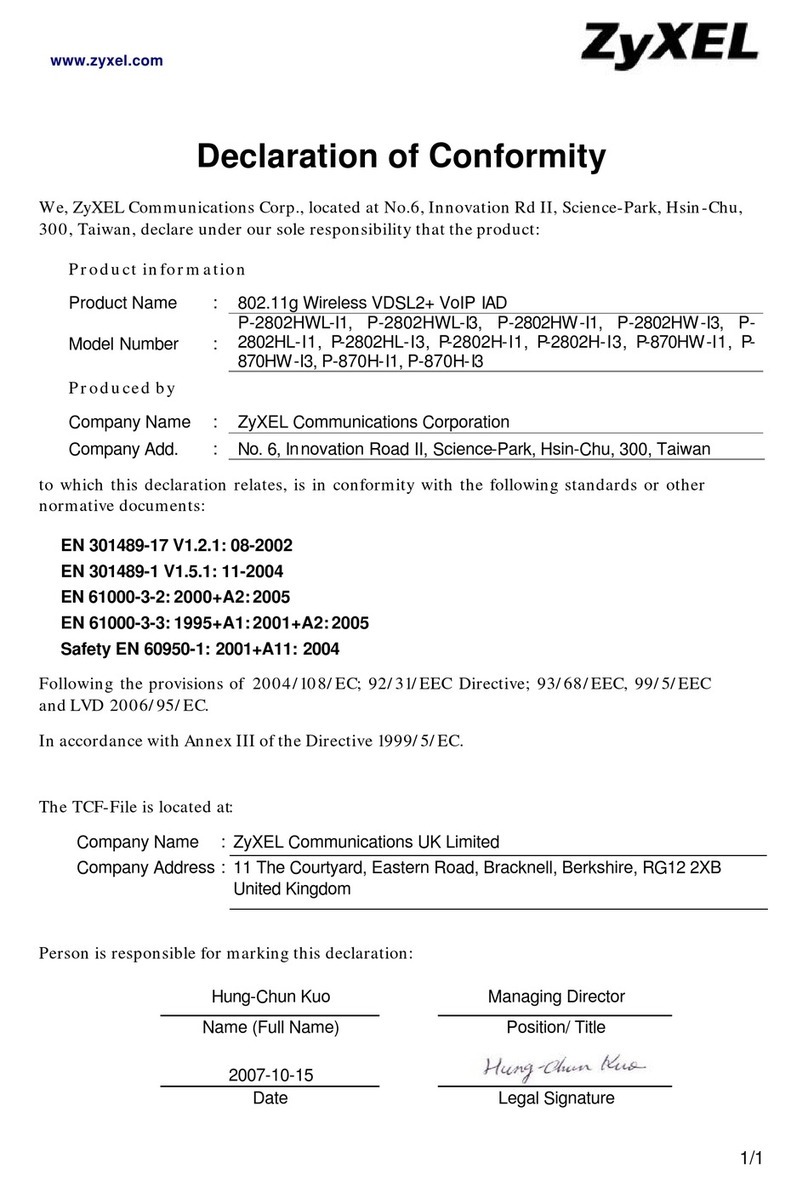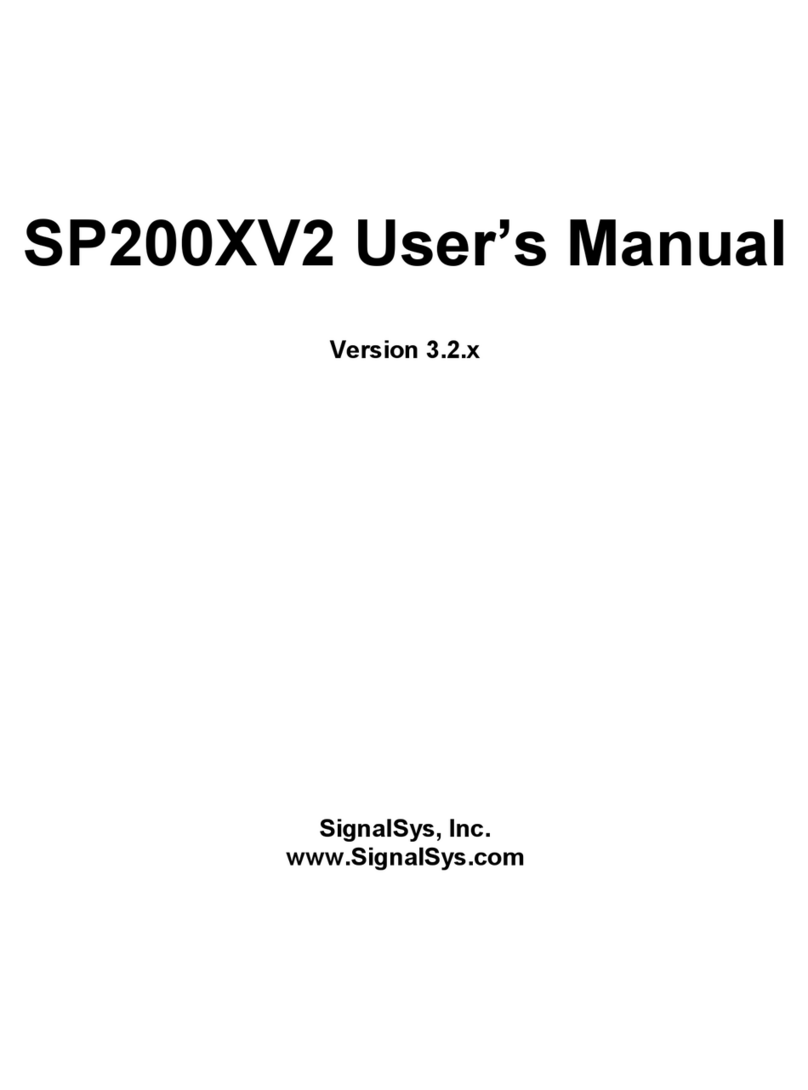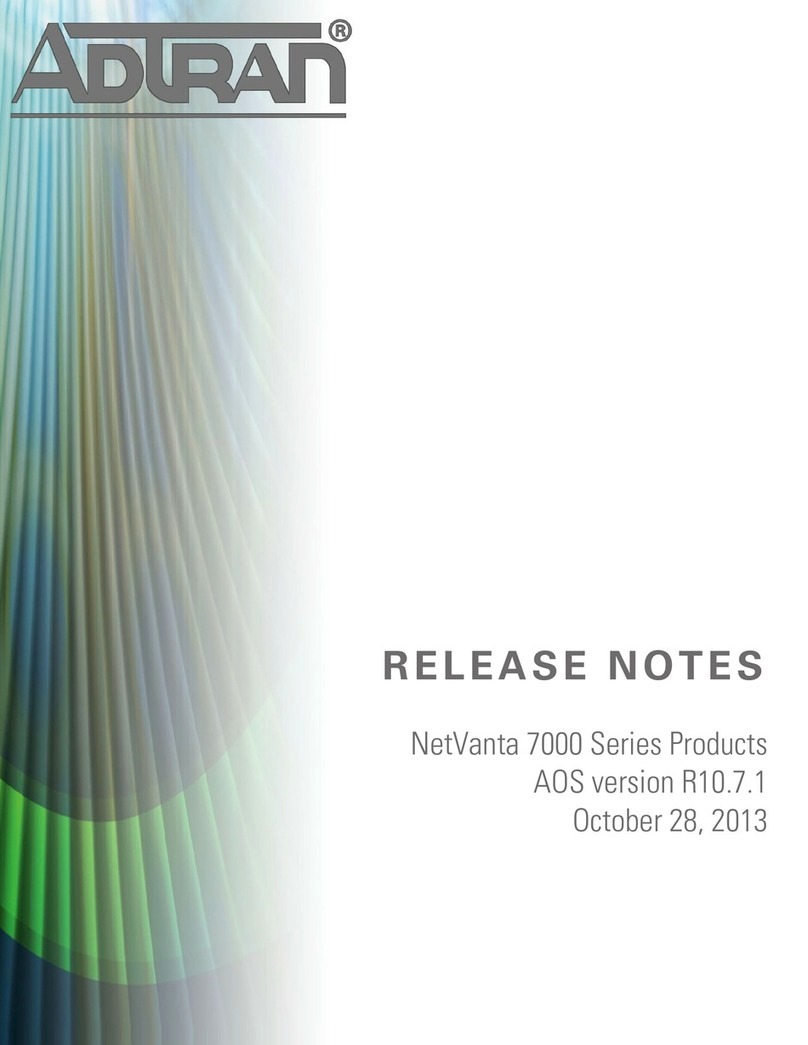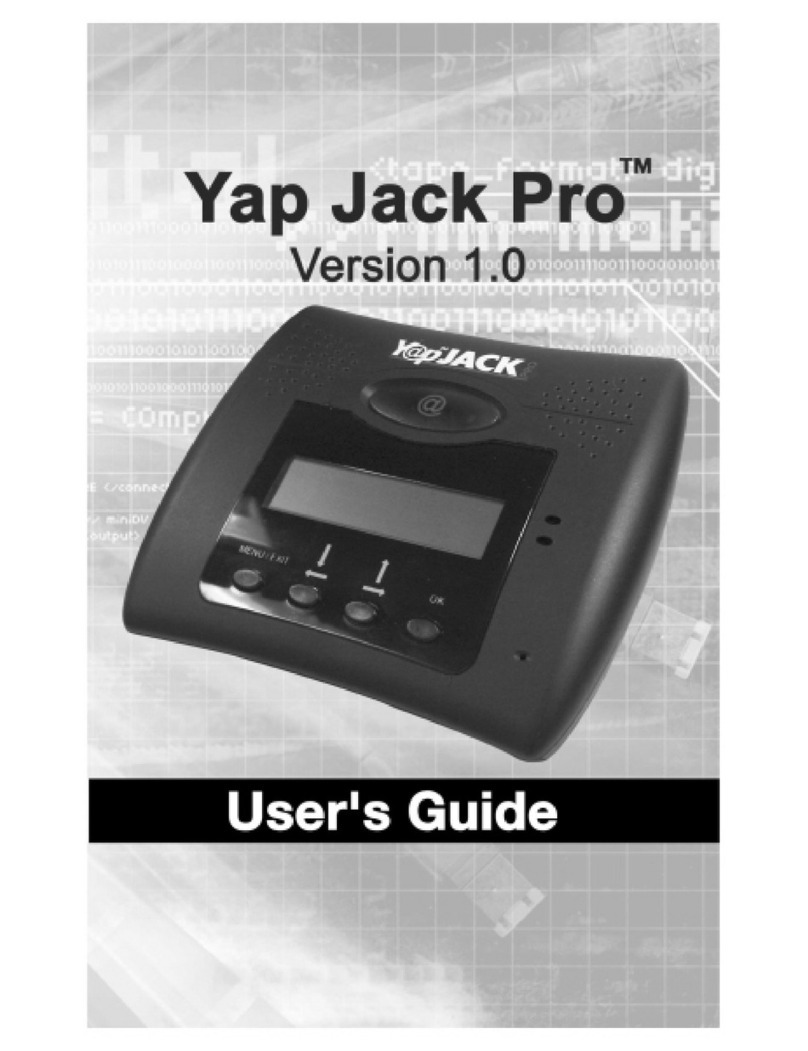AudioCodes Mediant 2000 User manual

Document #: LTRT-68806 September 2007
User's Manual Version 5.2


Version 5.2 3 September 2007
SIP User's Manual Contents
Table of Contents
1Overview............................................................................................................15
1.1 SIP Overview .........................................................................................................15
1.2 Mediant 2000 Overview ......................................................................................... 15
1.3 TP-1610 Overview .................................................................................................17
1.4 TP-260 Overview ...................................................................................................18
2Physical Description.........................................................................................19
2.1 Mediant 2000 Physical Description........................................................................19
2.1.1 Mediant 2000 Chassis .............................................................................................20
2.1.2 Power Supply...........................................................................................................20
2.1.3 Optional CPU Blade.................................................................................................21
2.2 TP-1610 Physical Description................................................................................21
2.2.1 TP-1610 Front Panel LEDs .....................................................................................22
2.2.2 TP-1610 Rear Transition Module ............................................................................23
2.3 TP-260 Physical Description ..................................................................................25
2.3.1 TP-260 LEDs ...........................................................................................................26
2.3.2 TP-260 Ethernet and E1/T1 Ports ...........................................................................27
3Installation .........................................................................................................29
3.1 Installing the Mediant 2000 ....................................................................................29
3.1.1 Unpacking................................................................................................................29
3.1.2 Package Contents ...................................................................................................30
3.1.3 Mounting the Mediant 2000 .....................................................................................30
3.1.3.1 Mounting Mediant 2000 on a Desktop .................................................... 31
3.1.3.2 Installing Mediant 2000 in a 19-inch Rack .............................................. 31
3.1.4 Cabling the Mediant 2000........................................................................................33
3.1.4.1 Grounding the Mediant 2000................................................................... 35
3.1.4.2 Connecting the E1/T1 Trunk Interfaces .................................................. 35
3.1.4.3 Connecting the Ethernet Interface .......................................................... 36
3.1.4.4 Connecting the RS-232 Port to a PC ...................................................... 37
3.1.4.5 Connecting the Power Supply................................................................. 38
3.2 Installing the TP-1610 ............................................................................................ 40
3.2.1 Unpacking................................................................................................................40
3.2.2 Package Contents ...................................................................................................41
3.2.3 Installing the TP-1610..............................................................................................41
3.2.3.1 Inserting Blades....................................................................................... 41
3.2.3.2 Removing Blades .................................................................................... 42
3.2.4 Cabling the TP-1610................................................................................................42
3.3 Installing the TP-260 .............................................................................................. 43
3.3.1 Unpacking................................................................................................................43
3.3.2 Package Contents ...................................................................................................44
3.3.3 Installing the TP-260................................................................................................44
3.3.4 Cabling the TP-260..................................................................................................44
3.3.4.1 Connecting the E1/T1 Trunk Interfaces .................................................. 45
3.3.4.2 Connecting the Ethernet Interface .......................................................... 46

SIP User's Manual 4 Document #: LTRT-68806
Mediant 2000 & TP-1610 & TP-260/UNI
4Getting Started ..................................................................................................47
4.1 Configuration Concepts..........................................................................................47
4.2 Startup Process......................................................................................................48
4.3 Assigning an IP Address........................................................................................ 50
4.3.1 Assigning an IP Address Using HTTP.....................................................................50
4.3.2 Assigning an IP Address Using BootP ....................................................................51
4.3.3 Assigning an IP Address Using the CLI...................................................................51
4.3.3.1 Accessing the CLI ................................................................................... 52
4.3.3.2 Assigning an IP Address ......................................................................... 53
4.4 Configuring Basic Parameters ...............................................................................54
5Web-based Management..................................................................................57
5.1 Computer Requirements ........................................................................................ 57
5.2 Protection and Security Mechanisms..................................................................... 57
5.2.1 User Accounts .........................................................................................................58
5.2.2 Limiting the Embedded Web Server to Read-Only Mode .......................................59
5.2.3 Disabling the Embedded Web Server .....................................................................59
5.3 Accessing the Embedded Web Server .................................................................. 60
5.4 Getting Acquainted with the Web Interface............................................................ 61
5.4.1 Main Menu Bar ........................................................................................................62
5.4.2 Saving Changes ......................................................................................................62
5.4.3 Entering Phone Numbers in Various Tables ...........................................................62
5.4.4 Searching for Configuration Parameters .................................................................63
5.4.5 Customizing the Web Interface ...............................................................................65
5.4.5.1 Replacing the Main Corporate Logo ....................................................... 65
5.4.5.2 Replacing the Background Image File .................................................... 68
5.4.5.3 Customizing the Product Name .............................................................. 69
5.4.5.4 Creating a Login Welcome Message ...................................................... 70
5.5 Protocol Management ............................................................................................ 71
5.5.1 Protocol Definition Parameters................................................................................71
5.5.1.1 General Parameters ................................................................................ 72
5.5.1.2 Proxy & Registration Parameters............................................................ 86
5.5.1.3 Coders..................................................................................................... 96
5.5.1.4 DTMF & Dialing Parameters ................................................................... 99
5.5.2 Configuring the Advanced Parameters................................................................. 102
5.5.2.1 General Parameters .............................................................................. 103
5.5.2.2 Supplementary Services ....................................................................... 109
5.5.2.3 Stand-Alone Survivability ...................................................................... 111
5.5.3 Configuring the Number Manipulation Tables ...................................................... 113
5.5.3.1 Dialing Plan Notation............................................................................. 116
5.5.3.2 Numbering Plans and Type of Number................................................. 117
5.5.3.3 Mapping NPI/TON to Phone-Context.................................................... 118
5.5.4 Configuring the Routing Tables ............................................................................ 120
5.5.4.1 General Parameters .............................................................................. 120
5.5.4.2 Tel to IP Routing Table.......................................................................... 122
5.5.4.3 IP to Trunk Group Routing .................................................................... 126
5.5.4.4 Internal DNS Table................................................................................ 128
5.5.4.5 Internal SRV Table ................................................................................ 129
5.5.4.6 Reasons for Alternative Routing ........................................................... 130
5.5.4.7 Release Cause Mapping....................................................................... 132

Version 5.2 5 September 2007
SIP User's Manual Contents
5.5.5 Configuring the Profile Definitions ........................................................................ 132
5.5.5.1 Coder Group Settings............................................................................ 133
5.5.5.2 Tel Profile Settings ................................................................................ 134
5.5.5.3 IP Profile Settings.................................................................................. 136
5.5.6 Configuring the Trunk Group Table ...................................................................... 138
5.5.7 Configuring the Trunk Group Settings .................................................................. 140
5.5.8 Configuring the Digital Gateway Parameters ....................................................... 142
5.5.9 Configuring the Advanced Applications................................................................ 147
5.5.9.1 Configuring RADIUS Accounting Parameters....................................... 147
5.5.9.2 Configuring the Voice Mail (VM) Parameters........................................ 149
5.6 Network Settings..................................................................................................152
5.6.1 Configuring the IP Settings................................................................................... 153
5.6.2 Configuring the Application Settings..................................................................... 157
5.6.3 Configuring the NFS Settings ............................................................................... 159
5.6.4 Configuring the IP Routing Table ......................................................................... 162
5.6.5 Configuring the VLAN Settings............................................................................. 164
5.7 Media Settings .....................................................................................................166
5.7.1 Configuring the Voice Settings ............................................................................. 166
5.7.2 Configuring the Fax / Modem / CID Settings........................................................ 168
5.7.3 Configuring the RTP / RTCP Settings .................................................................. 172
5.7.4 Configuring the IPmedia Settings ......................................................................... 176
5.7.5 Configuring the General Media Settings............................................................... 177
5.8 PSTN Settings...................................................................................................... 178
5.8.1 Configuring the PSTN Settings............................................................................. 178
5.8.1.1 Trunk Settings ....................................................................................... 178
5.8.1.2 CAS State Machines ............................................................................. 192
5.8.2 Configuring the TDM Bus Settings ....................................................................... 195
5.9 Security Settings ..................................................................................................197
5.9.1 Configuring the Web User Accounts .................................................................... 197
5.9.2 Configuring the Web and Telnet Access List........................................................ 199
5.9.3 Configuring the Firewall Settings.......................................................................... 200
5.9.4 Configuring the Certificates .................................................................................. 202
5.9.4.1 Server Certificate Replacement ............................................................ 202
5.9.4.2 Client Certificates .................................................................................. 203
5.9.4.3 Self-Signed Certificates......................................................................... 204
5.9.5 Configuring the General Security Settings ........................................................... 206
5.9.6 Configuring the IPSec Table................................................................................. 210
5.9.7 Configuring the IKE Table .................................................................................... 214
5.10 Configuring the Management Settings................................................................. 218
5.10.1 Configuring the SNMP Trap Destinations Table .................................................. 221
5.10.2 Configuring the SNMP Community Strings .......................................................... 222
5.10.3 Configuring SNMP V3 Users ................................................................................ 224
5.11 Status & Diagnostics............................................................................................ 226
5.11.1 Gateway Statistics ................................................................................................ 226
5.11.1.1 IP Connectivity ...................................................................................... 226
5.11.1.2 Call Counters......................................................................................... 228
5.11.1.3 Call Routing Status................................................................................ 231
5.11.1.4 SAS Registered Users .......................................................................... 232
5.11.2 Activating the Internal Syslog Viewer ................................................................... 233
5.11.3 Device Information................................................................................................ 234
5.11.4 Viewing the Ethernet Port Information.................................................................. 235
5.11.5 Viewing Performance Statistics ............................................................................ 235

SIP User's Manual 6 Document #: LTRT-68806
Mediant 2000 & TP-1610 & TP-260/UNI
5.11.6 Channel Status ..................................................................................................... 236
5.11.6.1 Viewing Trunk Port Settings.................................................................. 237
5.11.6.2 Assigning a Port Name.......................................................................... 238
5.11.6.3 Viewing Channel Information ................................................................ 239
5.12 Software Update ..................................................................................................240
5.12.1 Software Upgrade Wizard..................................................................................... 240
5.12.2 Automatic Update Mechanism.............................................................................. 245
5.12.3 Auxiliary Files........................................................................................................ 247
5.12.3.1 Loading the Auxiliary Files via the Embedded Web Server.................. 248
5.12.3.2 Loading the Auxiliary Files via the ini File ............................................. 249
5.12.4 Updating the Software Upgrade Key .................................................................... 249
5.12.4.1 Backing up the Current Software Upgrade Key .................................... 250
5.12.4.2 Loading the Software Upgrade Key ...................................................... 250
5.12.4.3 Verifying that the Key was Successfully Loaded .................................. 253
5.12.4.4 Troubleshooting an Unsuccessful Loading of a Key............................. 253
5.13 Maintenance.........................................................................................................254
5.13.1 Regional Settings.................................................................................................. 254
5.13.2 Locking and Unlocking the Gateway .................................................................... 254
5.13.3 Saving Configuration ............................................................................................ 256
5.13.4 Resetting the Gateway ......................................................................................... 257
5.13.5 Restoring and Backing up Configuration.............................................................. 258
5.13.6 Factory Default Settings ....................................................................................... 259
5.13.6.1 Defining Default Values......................................................................... 259
5.13.6.2 Restoring Default Settings .................................................................... 260
5.14 Using the Home Page ..........................................................................................260
5.14.1 Accessing the Home Page ................................................................................... 261
5.14.2 Switching between Mediant 2000 Modules .......................................................... 262
5.14.3 Viewing Ethernet Port Information........................................................................ 262
5.14.4 Viewing the Active Alarms Table .......................................................................... 263
5.14.5 Viewing Trunk Settings......................................................................................... 264
5.14.6 Assigning a Name to a Port.................................................................................. 266
5.15 Logging Off the Embedded Web Server ..............................................................266
6ini File Configuration ......................................................................................267
6.1 Secured ini File .................................................................................................... 267
6.2 Modifying an ini File .............................................................................................267
6.3 The ini File Content.............................................................................................. 268
6.4 The ini File Structure............................................................................................ 268
6.4.1 The ini File Structure Rules .................................................................................. 269
6.4.2 Structure of Individual ini File Parameters............................................................ 269
6.4.3 Structure of ini File Parameter Tables .................................................................. 269
6.4.4 The ini File Example ............................................................................................. 272
6.5 The ini File Parameter Reference ........................................................................ 272
6.5.1 Networking Parameters ........................................................................................ 273
6.5.2 System Parameters .............................................................................................. 280
6.5.3 Web and Telnet Parameters................................................................................. 287
6.5.4 Security Parameters ............................................................................................. 290
6.5.5 RADIUS Parameters............................................................................................. 291
6.5.6 SNMP Parameters................................................................................................ 293
6.5.7 SIP Configuration Parameters.............................................................................. 295
6.5.8 Media Server Parameters..................................................................................... 306
6.5.9 Voice Mail Parameters.......................................................................................... 306
6.5.10 PSTN Parameters................................................................................................. 307
6.5.11 ISDN and CAS Interworking-Related Parameters................................................ 311

Version 5.2 7 September 2007
SIP User's Manual Contents
6.5.12 Number Manipulation and Routing Parameters ................................................... 318
6.5.13 Channel Parameters............................................................................................. 332
6.5.14 Configuration Files Parameters ............................................................................ 337
7Telephony Capabilities...................................................................................339
7.1 Configuring the DTMF Transport Types...............................................................339
7.2 Fax and Modem Capabilities................................................................................ 340
7.2.1 Fax/Modem Operating Modes .............................................................................. 340
7.2.2 Fax/Modem Transport Modes .............................................................................. 341
7.2.2.1 T.38 Fax Relay Mode ............................................................................ 341
7.2.2.2 Fax/Modem Bypass Mode .................................................................... 342
7.2.2.3 Fax / Modem NSE Mode....................................................................... 343
7.2.2.4 G.711 Fax / Modem Transport Mode .................................................... 344
7.2.2.5 Fax Fallback .......................................................................................... 344
7.2.2.6 Fax / Modem Transparent Mode........................................................... 345
7.2.2.7 Fax / Modem Transparent with Events Mode ....................................... 345
7.2.3 Supporting V.34 Faxes ......................................................................................... 346
7.2.3.1 Using Bypass Mechanism for V.34 Fax Transmission.......................... 346
7.2.3.2 Using Relay mode for both T.30 and V.34 faxes .................................. 346
7.2.4 Supporting V.152 Implementation ........................................................................ 347
7.3 Event Notification using X-Detect Header............................................................348
7.4 RTP Multiplexing (ThroughPacket) ...................................................................... 349
7.5 Dynamic Jitter Buffer Operation ........................................................................... 350
7.6 Configuring Alternative Routing (Based on Connectivity and QoS) ..................... 351
7.6.1 Alternative Routing Mechanism............................................................................ 351
7.6.2 Determining the Availability of Destination IP Addresses..................................... 351
7.6.3 PSTN Fallback as a Special Case of Alternative Routing .................................... 352
7.6.4 Relevant Parameters ............................................................................................ 352
7.7 Call Detail Record ................................................................................................ 352
7.8 Supported RADIUS Attributes.............................................................................. 354
7.8.1 RADIUS Server Messages ................................................................................... 356
7.9 Trunk-to-Trunk Routing Example ......................................................................... 356
7.10 Proxy or Registrar Registration Example ............................................................. 357
7.11 Configuration Examples.......................................................................................358
7.11.1 SIP Call Flow ........................................................................................................ 358
7.11.2 SIP Authentication Example ................................................................................. 361
7.12 Working with Supplementary Services.................................................................363
7.12.1 Call Hold and Retrieve.......................................................................................... 363
7.12.2 Call Transfer ......................................................................................................... 364
8Networking Capabilities..................................................................................365
8.1 Ethernet Interface Configuration .......................................................................... 365
8.2 Ethernet Interface Redundancy ...........................................................................365
8.3 NAT (Network Address Translation) Support.......................................................366
8.3.1 STUN .................................................................................................................... 367
8.3.2 First Incoming Packet Mechanism........................................................................ 368
8.3.3 No-Op Packets ..................................................................................................... 368

SIP User's Manual 8 Document #: LTRT-68806
Mediant 2000 & TP-1610 & TP-260/UNI
8.4 Point-to-Point Protocol over Ethernet (PPPoE)....................................................369
8.4.1 Point-to-Point Protocol (PPP) Overview ............................................................... 369
8.4.2 PPPoE Overview .................................................................................................. 370
8.4.3 PPPoE in AudioCodes gateway ........................................................................... 370
8.5 IP Multicasting...................................................................................................... 371
8.6 Robust Reception of RTP Streams ...................................................................... 371
8.7 Multiple Routers Support...................................................................................... 371
8.8 Simple Network Time Protocol Support ............................................................... 372
8.9 IP QoS via Differentiated Services (DiffServ).......................................................372
8.10 VLANS and Multiple IPs....................................................................................... 373
8.10.1 Multiple IPs ........................................................................................................... 373
8.10.2 IEEE 802.1p/Q (VLANs and Priority).................................................................... 373
8.10.3 Getting Started with VLANS and Multiple IPs ...................................................... 376
8.10.3.1 Integrating Using the Embedded Web Server ...................................... 376
8.10.3.2 Integrating Using the ini File.................................................................. 380
9Advanced PSTN Configuration......................................................................381
9.1 Clock Settings ......................................................................................................381
9.2 Release Reason Mapping.................................................................................... 382
9.2.1 Reason Header..................................................................................................... 382
9.2.2 Fixed Mapping of ISDN Release Reason to SIP Response................................. 383
9.2.3 Fixed Mapping of SIP Response to ISDN Release Reason................................. 385
9.3 ISDN Overlap Dialing ........................................................................................... 386
9.4 Using ISDN NFAS................................................................................................ 387
9.4.1 NFAS Interface ID................................................................................................. 387
9.4.2 Working with DMS-100 Switches ......................................................................... 388
9.4.3 Creating an NFAS-Related Trunk Configuration On-The-Fly............................... 389
9.5 Redirect Number and Calling Name (Display) .....................................................390
10 Tunneling Applications...................................................................................391
10.1 TDM Tunneling..................................................................................................... 391
10.1.1 Implementation ..................................................................................................... 391
10.2 QSIG Tunneling ...................................................................................................394
10.2.1 Implementation ..................................................................................................... 394
11 Selected Technical Specifications.................................................................395
11.1 General Specifications .........................................................................................395
11.2 Mediant 2000 Specifications ................................................................................ 397
11.3 TP-1610 Specifications ........................................................................................399
11.4 TP-260 Specifications ..........................................................................................401
12 Supplied SIP Software Package.....................................................................403

Version 5.2 9 September 2007
SIP User's Manual Contents
List of Figures
Figure 1-1: Mediant 2000 Typical Application ........................................................................................16
Figure 2-1: Mediant 2000 Front Panel....................................................................................................19
Figure 2-2: Front View of TP-1610 cPCI Blade ......................................................................................21
Figure 2-3: RTM-1610 Rear Panel with two 50-pin Connectors for 16 Trunks ......................................24
Figure 2-4: RTM-1610 with 8 RJ-48c Connectors for 8 Trunks .............................................................24
Figure 2-5: TP-260 Board Description....................................................................................................25
Figure 2-6: RJ-45 Connector Pinouts.....................................................................................................27
Figure 2-7: RJ-48c Connector Pinouts ...................................................................................................27
Figure 3-1: 19-inch Rack and Desktop Accessories ..............................................................................30
Figure 3-2: Front View with 19-inch Rack-Mount Brackets ....................................................................32
Figure 3-3: Rear-Panel Cabling (e.g., 16 Trunks, Dual AC Power) .......................................................33
Figure 3-4: Rear-Panel Cabling (8 Trunks, DC Power)..........................................................................34
Figure 3-5: 50-pin Female Telco Board-Mounted Connector.................................................................35
Figure 3-6: RJ-48c Connector Pinouts ...................................................................................................36
Figure 3-7: RJ-45 Connector Pinouts.....................................................................................................37
Figure 3-8: RS-232 Connector Pinouts ..................................................................................................37
Figure 3-9: DC Power Terminal Block Screw Connector .......................................................................39
Figure 3-10: DC Power Terminal Block Crimp Connector .....................................................................39
Figure 3-11: RJ-48c Connector Pinouts .................................................................................................45
Figure 3-12: E1/T1 Cable Splitter...........................................................................................................45
Figure 3-13: RJ-45 Connector Pinouts...................................................................................................46
Figure 4-1: Startup Process....................................................................................................................49
Figure 4-2: Quick Setup Screen .............................................................................................................54
Figure 5-1: Enter Network Password Screen.........................................................................................60
Figure 5-2: Searched Result Screen ......................................................................................................63
Figure 5-3: Searched Parameter Highlighted in Screen ........................................................................64
Figure 5-4: Customized Web Interface Title Bar ....................................................................................65
Figure 5-5: Customized Web Interface Title Bar ....................................................................................65
Figure 5-6: Image Download Screen......................................................................................................66
Figure 5-7: User-Defined Web Welcome Message after Login..............................................................70
Figure 5-8: General Parameters (Protocol Definition Submenu) ...........................................................72
Figure 5-9: Proxy & Registration Screen................................................................................................86
Figure 5-10: Coders Screen ...................................................................................................................96
Figure 5-11: DTMF & Dialing Screen .....................................................................................................99
Figure 5-12: Stand-Alone Survivability Screen.................................................................................... 112
Figure 5-13: Source Phone Number Manipulation Table for Tel-to-IP Calls....................................... 114
Figure 5-14: Phone Context Table Screen.......................................................................................... 118
Figure 5-15: Routing Tables - General Parameters Screen................................................................ 120
Figure 5-16: Tel to IP Routing Table Screen....................................................................................... 124
Figure 5-17: IP to Trunk Group Routing Table Screen ....................................................................... 127
Figure 5-18: Internal DNS Table Screen ............................................................................................. 129
Figure 5-19: Internal SRV Table Screen ............................................................................................. 130
Figure 5-20: Reasons for Alternative Routing Screen......................................................................... 131
Figure 5-21: Release Cause Mapping Screen (e.g., ISDN to SIP) ..................................................... 132
Figure 5-22: Coder Group Settings Screen......................................................................................... 133
Figure 5-23: IP Profile Settings Screen ............................................................................................... 137
Figure 5-24: Trunk Group Table Screen ............................................................................................. 138
Figure 5-25: Trunk Group Settings Screen ......................................................................................... 140
Figure 5-26: Digital Gateway Parameters Screen............................................................................... 142
Figure 5-27: RADIUS Parameters Screen .......................................................................................... 148
Figure 5-28: IP Settings Screen .......................................................................................................... 153
Figure 5-29: Application Settings Screen ............................................................................................ 157
Figure 5-30: NFS Settings Screen ...................................................................................................... 160
Figure 5-31: IP Routing Tablre Screen................................................................................................ 162
Figure 5-32: VLAN Settings Screen .................................................................................................... 164

SIP User's Manual 10 Document #: LTRT-68806
Mediant 2000 & TP-1610 & TP-260/UNI
Figure 5-33: Voice Settings Screen..................................................................................................... 166
Figure 5-34: Fax / Modem / CID Settings Screen ............................................................................... 168
Figure 5-35: IPmedia Settings Screen ................................................................................................ 176
Figure 5-36: General Media Settings Screen...................................................................................... 177
Figure 5-37: CAS State Machine Table Screen .................................................................................. 192
Figure 5-38: TDM Bus Settings Screen............................................................................................... 195
Figure 5-39: Web User Accounts Screen (for Users with 'Security Administrator' Privileges)............ 198
Figure 5-40: Web & Telnet Access List Screen................................................................................... 199
Figure 5-41: Firewall Settings Screen ................................................................................................. 200
Figure 5-42: Certificates Signing Request Screen .............................................................................. 202
Figure 5-43: IPSec Table Screen ........................................................................................................ 210
Figure 5-44: IKE Table Screen............................................................................................................ 214
Figure 5-45: SNMP Trap Destinations Screen .................................................................................... 221
Figure 5-46: SNMP Community Strings Screen.................................................................................. 223
Figure 5-47: SNMP V3 Setting Screen................................................................................................ 224
Figure 5-48: IP Connectivity Screen.................................................................................................... 227
Figure 5-49: Calls Count Screen (e.g., Tel to IP) ................................................................................ 229
Figure 5-50: Call Routing Status Screen............................................................................................. 231
Figure 5-51: SAS Registered Users Screen........................................................................................ 232
Figure 5-52: Message Log Screen ...................................................................................................... 233
Figure 5-53: Device Information Screen.............................................................................................. 234
Figure 5-54: Ethernet Port Information Screen ................................................................................... 235
Figure 5-55: Basic Statistics Screen ................................................................................................... 236
Figure 5-56: Trunk & Channel Status Screen ..................................................................................... 236
Figure 5-57: Shortcut Menu for Viewing Trunk Settings ..................................................................... 237
Figure 5-58: Shortcut Menu for Assigning a Port Name ..................................................................... 238
Figure 5-59: Basic Information Screen................................................................................................ 239
Figure 5-60: Start Software Upgrade Wizard Screen.......................................................................... 241
Figure 5-61: End Process Wizard Screen ........................................................................................... 244
Figure 5-62: Software Upgrade Key with Multiple S/N Lines .............................................................. 252
Figure 5-63: Regional Settings Screen ............................................................................................... 254
Figure 5-64: Maintenance Actions Screen .......................................................................................... 255
Figure 5-65: Maintenance Actions Screen .......................................................................................... 256
Figure 5-66: Maintenance Actions Screen .......................................................................................... 257
Figure 5-67: Configuration File Screen ............................................................................................... 258
Figure 5-68: Home Page ..................................................................................................................... 261
Figure 5-69: Confirmation Message Box for Switching Modules ........................................................ 262
Figure 5-70: Ethernet Port Information Screen ................................................................................... 263
Figure 5-71: Active Alarms Screen...................................................................................................... 264
Figure 5-72: Trunk Settings Screen .................................................................................................... 265
Figure 5-73: Shortcut Menu for Assigning a Port Name ..................................................................... 266
Figure 5-74: Log Off Confirmation Box................................................................................................ 266
Figure 7-1: SIP Call Flow..................................................................................................................... 358
Figure 8-1: VLAN Settings Screen - Example..................................................................................... 377
Figure 8-2: IP Settings Screen - Example........................................................................................... 378
Figure 8-3: IP Routing Table - Example .............................................................................................. 378

Version 5.2 11 September 2007
SIP User's Manual Contents
List of Tables
Table 2-1: Mediant 2000 Front View Component Descriptions..............................................................20
Table 2-2: Chassis LEDs Description.....................................................................................................20
Table 2-3: Front and Upper View of the TP-1610 cPCI Blade Component Descriptions ......................22
Table 2-4: Status LEDs Description .......................................................................................................22
Table 2-5: E1/T1 Trunk Status LEDs Description ..................................................................................22
Table 2-6: Ethernet LEDs Description....................................................................................................23
Table 2-7: cPCI LEDs Description..........................................................................................................23
Table 2-8: Rear Panel with two 50-pin Connectors for 16 Trunks Component Descriptions.................24
Table 2-9: Rear Panel with Eight RJ-48c Connectors for 8 Trunks Component Descriptions...............24
Table 2-10: TP-260 Component Description..........................................................................................25
Table 2-11: Ethernet LEDs Description..................................................................................................26
Table 2-12: E1/T/J1 LEDs on the Front Panel (Bracket) Description ....................................................26
Table 2-13: Internally Located Base Blade LEDs Description ...............................................................26
Table 3-1: Mediant 2000 Rear Panel Cabling (16 Trunks, Dual AC Power) Component Descriptions .33
Table 3-2: Mediant 2000 Rear Panel Cabling (8 Trunks, DC Power) Component Descriptions ...........34
Table 3-3: E1/T1 Connections on each 50-pin Telco Connector ...........................................................35
Table 4-1: Default Networking Parameters ............................................................................................47
Table 5-1: Available Access Levels and their Privileges.......................................................................58
Table 5-2: Default Attributes for the Accounts........................................................................................58
Table 5-3: Customizable Logo ini File Parameters ................................................................................67
Table 5-4: Web Appearance Customizable ini File Parameters ............................................................67
Table 5-5: Customizable Logo ini File Parameters ................................................................................69
Table 5-6: Web Appearance Customizable ini File Parameters ............................................................69
Table 5-7: User-Defined Welcome Message ini File Parameter............................................................70
Table 5-8: General Parameters (Protocol Definition) .............................................................................73
Table 5-9: Proxy & Registration Parameters..........................................................................................87
Table 5-10: Supported Coders ...............................................................................................................97
Table 5-11: DTMF and Dialing Parameters......................................................................................... 100
Table 5-12: General Parameters (Advanced Parameters).................................................................. 104
Table 5-13: Supplementary Services Parameters .............................................................................. 110
Table 5-14: Stand-Alone Survivability Parameters ............................................................................. 112
Table 5-15: Number Manipulation Parameters ................................................................................... 115
Table 5-16: Dialing Plan Notations...................................................................................................... 116
Table 5-17: NPI/TON Values for ISDN ETSI....................................................................................... 117
Table 5-18: Phone-Context Parameters.............................................................................................. 119
Table 5-19: General Parameters (Routing Tables) ............................................................................. 121
Table 5-20: Tel to IP Routing Table .................................................................................................... 125
Table 5-21: IP to Trunk Group Routing Table ..................................................................................... 127
Table 5-22: Trunk Group Table ........................................................................................................... 139
Table 5-23: Hunt Group Settings Parameters..................................................................................... 141
Table 5-24: Digital Gateway Parameters ............................................................................................ 143
Table 5-25: RADIUS Parameters ........................................................................................................ 148
Table 5-26: Voice Mail Parameters ..................................................................................................... 150
Table 5-27: Network Settings -- IP Settings Parameters .................................................................... 154
Table 5-28: Network Settings, Application Settings Parameters......................................................... 158
Table 5-29: Network Settings -- NFS Settings Parameters................................................................. 161
Table 5-30: IP Routing Table Column Description.............................................................................. 162
Table 5-31: Network Settings -- VLAN Settings Parameters .............................................................. 164
Table 5-32: Media Settings, Voice Settings Parameters..................................................................... 167
Table 5-33: Media Settings -- Fax/Modem/CID Parameters ............................................................... 169
Table 5-34: Media Settings, RTP / RTCP Parameters........................................................................ 173
Table 5-35: Media Server Parameters ................................................................................................ 177
Table 5-36: Media Settings - General Media Settings Parameters..................................................... 178
Table 5-37: E1/T1/J1 Configuration Parameters................................................................................. 182
Table 5-38: CAS State Machine Parameters ...................................................................................... 193

SIP User's Manual 12 Document #: LTRT-68806
Mediant 2000 & TP-1610 & TP-260/UNI
Table 5-39: TDM Bus Settings Parameters......................................................................................... 195
Table 5-40: Internal Firewall Parameters ............................................................................................ 201
Table 5-41: General Security Settings Parameters............................................................................. 207
Table 5-42: IPSec SPD Table Configuration Parameters ................................................................... 211
Table 5-43: Default IKE Second Phase Proposals ............................................................................. 212
Table 5-44: IKE Table Configuration Parameters ............................................................................... 215
Table 5-45: Default IKE First Phase Proposals................................................................................... 216
Table 5-46: Management Settings Parameters................................................................................... 219
Table 5-47: SNMP Trap Destinations Table Parameters.................................................................... 222
Table 5-48: SNMP Community Strings Parameters............................................................................ 223
Table 5-49: SNMP V3 Users Parameters ........................................................................................... 224
Table 5-50: IP Connectivity Parameters.............................................................................................. 227
Table 5-51: Call Counters Description ................................................................................................ 229
Table 5-52: Call Routing Status Parameters....................................................................................... 232
Table 5-53: SAS Registered Users Parameters ................................................................................. 232
Table 5-54: Ethernet Port Information Parameters ............................................................................. 235
Table 5-55: Color Coding for Trunk and Channel Status .................................................................... 237
Table 5-56: Auxiliary Files Descriptions .............................................................................................. 247
Table 5-57: Description of the Areas of the Home Page..................................................................... 261
Table 6-1: Networking Parameters...................................................................................................... 273
Table 6-2: System Parameters............................................................................................................ 280
Table 6-3: Web and Telnet Parameters .............................................................................................. 287
Table 6-4: Security Parameters........................................................................................................... 290
Table 6-5: RADIUS Parameter............................................................................................................ 291
Table 6-6: SNMP Parameters ............................................................................................................. 293
Table 6-7: SIP Configuration Parameters ........................................................................................... 295
Table 6-8: Media Server Configuration Parameters............................................................................ 306
Table 6-9: Voice Mail Configuration Parameters ................................................................................ 306
Table 6-10: PSTN Parameters ............................................................................................................ 307
Table 6-11: ISDN and CAS Interworking-Related Parameters ........................................................... 311
Table 6-12: Number Manipulation and Routing Parameters............................................................... 318
Table 6-13: Channel Parameters ........................................................................................................ 332
Table 6-14: Configuration Files Parameters........................................................................................ 337
Table 7-1: Supported X-Detect Event Types....................................................................................... 348
Table 7-2: Supported CDR Fields ....................................................................................................... 352
Table 7-3: Supported RADIUS Attributes............................................................................................ 354
Table 8-1: Traffic / Network Types and Priority................................................................................... 374
Table 8-2: Example of VLAN and Multiple IPs Configuration.............................................................. 376
Table 9-1: Mapping of ISDN Release Reason to SIP Response ........................................................ 383
Table 9-2: Mapping of SIP Response to ISDN Release Reason........................................................ 385
Table 9-3: Calling Name (Display) ...................................................................................................... 390
Table 9-4: Redirect Number ................................................................................................................ 390
Table 11-1: General Selected Technical Specifications...................................................................... 395
Table 11-2: Mediant 2000 Selected Technical Specifications............................................................. 397
Table 11-3: TP-1610 Selected Technical Specifications..................................................................... 399
Table 11-4: TP-260 Selected Technical Specifications....................................................................... 401
Table 12-1: Supplied Software Package............................................................................................. 403

Version 5.2 13 September 2007
SIP User's Manual Notices
Notice
This document describes the AudioCodes Mediant 2000 SIP gateway, TP-1610 SIP cPCI
blade, and TP-260 SIP PCI board.
Information contained in this document is believed to be accurate and reliable at the time of
printing. However, due to ongoing product improvements and revisions, AudioCodes cannot
guarantee accuracy of printed material after the Date Published nor can it accept responsibility
for errors or omissions. Updates to this document and other documents can be viewed by
registered Technical Support customers at http://www.audiocodes.com Under Support /
Product Documentation.
© Copyright 2007 AudioCodes Ltd. All rights reserved.
This document is subject to change without notice.
Date Published: Aug-30-2007 Date Printed: Sep-02-2007
Tip: When viewing this manual on CD, Web site or on any other electronic copy,
all cross-references are hyperlinked. Click on the page or section numbers
(shown in blue) to reach the individual cross-referenced item directly. To
return back to the point from where you accessed the cross-reference, press
the ALT and Åkeys
Trademarks
AC logo, Ardito, AudioCoded, AudioCodes, AudioCodes logo, CTI², CTI Squared, InTouch,
IPmedia, Mediant, MediaPack, MP-MLQ, NetCoder, Netrake, Nuera, Open Solutions
Network, OSN, Stretto, 3GX, TrunkPack, VoicePacketizer, VoIPerfect, What's Inside
Matters, Your Gateway To VoIP, are trademarks or registered trademarks of AudioCodes
Limited. All other products or trademarks are property of their respective owners.
WEEE EU Directive
Pursuant to the WEEE EU Directive, electronic and electrical waste must not be disposed
of with unsorted waste. Please contact your local recycling authority for disposal of this
product.
Customer Support
Customer technical support and service are provided by AudioCodes’ Distributors,
Partners, and Resellers from whom the product was purchased. For Customer support for
products purchased directly from AudioCodes, contact support@audiocodes.com.
Abbreviations and Terminology
Each abbreviation, unless widely used, is spelled out in full when first used. Only industry-
standard terms are used throughout this manual. Hexadecimal notation is indicated by 0x
preceding the number.

SIP User's Manual 14 Document #: LTRT-68806
Mediant 2000 & TP-1610 & TP-260/UNI
Related Documentation
Document # Manual Name
LTRT-523xx (where xx is the
document version)
SIP Series Reference Manual
LTRT-690xx Mediant 3000 & Mediant 2000 & TP Series SIP Release Notes
LTRT-701xx Mediant 2000 MGCP-MEGACO-SIP Fast Track Guide
LTRT-665xx CPE Configuration Guide for IP Voice Mail
Warning: The gateway is supplied as a sealed unit and must only be serviced by
qualified service personnel.
Note: Where ‘network’ appears in this manual, it means Local Area Network (LAN),
Wide Area Network (WAN), etc. accessed via the gateway’s Ethernet
interface.
Note: Throughout this manual, unless otherwise specified, the term gateway refers
to the Mediant 2000 system, TP-1610 blade, and TP-260 PCI board.
Note: The terms IP-to-Tel and Tel-to-IP refer to the direction of the call relative to
the AudioCodes device: IP-to-Tel refers to calls received from the IP network
and destined to the PSTN (i.e., telephone connected directly or indirectly to
the device); Tel-to-IP refers to calls received from the PSTN and destined for
the IP network.

Version 5.2 15 September 2007
SIP User's Manual 1. Overview
1 Overview
This manual provides you with the information for installing, configuring, and operating the
Mediant 2000 SIP gateway, TP-1610 SIP cPCI board, and TP-260 SIP PCI board. As
these products have similar functionality (with the exception of their physical layout and the
number of trunks), they are collectively referred to throughout this manual (unless
otherwise specified) as the gateway.
1.1 SIP Overview
Session Initialization Protocol (SIP) is an application-layer control (signaling) protocol used
on the gateway for creating, modifying, and terminating sessions with one or more
participants. These sessions can include Internet telephone calls, media announcements,
and conferences.
SIP invitations are used to create sessions and carry session descriptions that enable
participants to agree on a set of compatible media types. SIP uses elements called Proxy
servers to help route requests to the user's current location, authenticate and authorize
users for services, implement provider call-routing policies and provide features to users.
SIP also provides a registration function that enables users to upload their current locations
for use by Proxy servers. SIP implemented in the gateway, complies with the Internet
Engineering Task Force (IETF) RFC 3261 (refer to http://www.ietf.org).
1.2 Mediant 2000 Overview
The Mediant 2000 system is a SIP-based Voice-over-IP (VoIP) media gateway. Mediant
2000 enables voice, fax, and data traffic to be sent over the same IP network.
The Mediant 2000 provides excellent voice quality and optimized packet voice streaming
over IP networks. The Mediant 2000 uses the award-winning, field-proven VoIPerfect™
voice compression technology, typically implemented in AudioCodes products.
The Mediant 2000 incorporates 1, 2, 4, 8 or 16 E1, T1, or J1 spans for direct connection to
the Public Switched Telephone Network (PSTN) / Private Branch Exchange (PBX) through
digital telephony trunks. The gateway also includes two 10/100 Base-TX Ethernet ports,
providing redundancy connection to the network.
The Mediant 2000 supports up to 480 simultaneous VoIP or Fax over IP (FoIP) calls,
supporting various Integrated Services Digital Network (ISDN) Primary Rate Interface (PRI)
protocols such as EuroISDN, North American NI2, Lucent™ 4/5ESS, Nortel™DMS100 and
others. In addition, it supports different variants of Channel Associated Signaling (CAS)
protocols for E1 and T1 spans, including MFC R2, E&M immediate start, E&M delay
dial/start, loop start and ground start.
The gateway, best suited for large and medium-sized VoIP applications, is a compact
device, comprising a 19-inch, 1U chassis with optional dual AC or single DC power
supplies. The deployment architecture can include several gateways in branch or
departmental offices, connected to local PBXs. Call routing is performed by the gateways
using internal routing or SIP Proxy(s).
The gateway enables users to make cost-effective, long distance or international
telephone/fax calls between distributed company offices, using their existing
telephones/fax. These calls can be routed over the existing network using state-of-the-art
compression techniques, ensuring that voice traffic uses minimum bandwidth.

SIP User's Manual 16 Document #: LTRT-68806
Mediant 2000 & TP-1610 & TP-260/UNI
The gateway can also route calls over the network using SIP signaling protocol, enabling
the deployment of Voice over Packet solutions in environments where access is enabled to
PSTN subscribers by using a trunking gateway. This provides the ability to transmit voice
and telephony signals between a packet network and a TDM network.
Notes:
•The Mediant 2000 is offered as a 1-module (up to 240 channels or 8
trunk spans) or 2-module (for 480 channels or 16 trunk spans only)
platform. The latter configuration supports two TrunkPack modules, each
having its own IP address. Configuration instructions in this document
relate to the Mediant 2000 as a 1-module platform and must be repeated
for the second module as well.
•For channel capacity, refer to the Mediant 2000 specifications.
The figure below illustrates a typical Mediant 2000 applications VoIP network:
Figure 1-1: Mediant 2000 Typical Application

Version 5.2 17 September 2007
SIP User's Manual 1. Overview
1.3 TP-1610 Overview
The TP-1610 is a complete SIP-compliant VoIP "gateway-on-a-blade", using cPCI form-
factor and based on single or dual TPM-1100 PMC modules, delivering a cost-effective
solution.
The TP-1610 is an ideal solution for SIP trunking gateways and integrated gateways for IP-
PBXs and all-in-one communication servers. The blade is designed for enterprise or carrier
applications. The TP-1610 provides up to 480 simultaneous ports for voice, fax or data for
VoIP gateway applications providing excellent voice quality and optimized packet voice
streaming over IP networks. The TP-1610 implements the award-winning, field-proven
VoIPerfect™ voice compression technology typically used in other AudioCodes products.
Employing SIP as a control protocol, the TP-1610 enables vendors and System
Integrators (SIs) short time-to-market and reliable cost-effective deployment of next-
generation networks.
The TP-1610 matches the density requirements for small to medium locations, while
meeting Network Service Providers' (NSP) demands for scalability. The TP-1610 scales
from 1 trunk span to 16 E1/T1/J1 spans (1, 2, 4, 8 or 16 E1, T1, or J1 spans) for direct
connection to PSTN / PBX telephony trunks, and includes two 10/100 Base-TX Ethernet
ports for redundant connection to the network. Thus, the blade provides an excellent
gateway solution for enterprise applications as well as carrier locations.
One or two packet processors (depending on the blade's capacity) handle packet-
streaming functions through two, redundant integral 10/100 Base-TX interfaces. Each
processor implements the industry-standard RTP/RTCP packet-streaming protocol,
advanced adaptive jitter buffer management, and T.38 fax relay over IP.
The TP-1610 supports various ISDN PRI protocols such as EuroISDN, North American
NI2, Lucent™ 4/5ESS, Nortel™ DMS100 and others. In addition, it supports different
variants of CAS protocols for E1 and T1 spans, including MFC R2, E&M immediate start,
E&M delay dial / start, loop start and ground start.
The TP-1610 enables the deployment of ‘Voice over Packet’ solutions in environments
where access is enabled to PSTN subscribers by using a trunking media gateway. This
provides the ability to transmit voice and telephony signals between a packet network and
a TDM network. Routing of the calls from the PSTN to a SIP service node (e.g., Call
Center) is performed by the TP-1610 internal routing feature or by a SIP Proxy.
Enabling accelerated design cycles with higher density and reduced costs, the TP-1610 is
an ideal building block for scalable, reliable VoIP solutions. With the TP-1610’s
comprehensive feature set, customers can quickly design a wide range of solutions for
PSTN and VoIP networks.
Note: The TP-1610 is offered as a 1-module (up to 240 channels or 8 trunk spans)
or 2-module (for 480 channels or 16 trunk spans only) platform. The latter
configuration supports two TrunkPack modules, each having its own IP
address. Configuration instructions in this document relate to the TP-1610 as
a 1-module platform and must be repeated for the second module as well.

SIP User's Manual 18 Document #: LTRT-68806
Mediant 2000 & TP-1610 & TP-260/UNI
1.4 TP-260 Overview
The TP-260 is a complete SIP-compliant, VoIP media processing server and VoIP
gateway. The SIP-compliant "gateway on a blade’, delivers a cost-effective solution in a
convenient PCI form-factor. This unique stand-alone PCI gateway operates independently
and only relies on the host PCI for its power. The TP-260 communicates to applications via
SIP using an on-board Ethernet interface. Using a special standards-based approach
eliminates host PC device drivers and operation system dependencies, seamlessly
connecting existing PSTN-based systems to support VoIP.
The TP-260 is an ideal solution for SIP trunking gateways and integrated gateways for IP-
PBXs and all-in-one communication servers. The blade is designed for enterprise
applications or for smaller to medium PC-based systems. The TP-260 provides up to 240
simultaneous ports for voice, fax or data for VoIP gateway applications providing excellent
voice quality and optimized packet voice streaming over IP networks. Employing SIP as a
control protocol, the TP-260 enables System Integrators short time-to-market and reliable
cost-effective deployment of next-generation networks. The TP-260 utilizes the TPM-1100
PMC module, which is based on the VolPerfect™ architecture, AudioCodes' underlying
core media gateway technology.
The TP-260 matches the density requirements for small to medium locations, while
meeting NSP’s demands for scalability. The TP-260 stand-alone VoIP gateway on a blade,
scales from 1 to 8 E1/T1/J1 spans (1, 2, 4, or 8 spans) in a single PCI slot and provides an
excellent gateway solution for enterprise applications as well as carrier locations.
The TP-260 supports various ISDN PRI protocols such as EuroISDN, North American NI2,
Lucent™ 4/5ESS, Nortel™ DMS100 and others. In addition, it supports different variants of
CAS protocols for E1 and T1 spans, including MFC R2, E&M immediate start, E&M delay
dial / start, loop start and ground start.
The deployment architecture can include several TP-260 gateways in branch or
departmental offices; connected to local PBXs. Call routing is performed by the gateways
using internal routing or SIP Proxy(s). The TP-260 enables users to make cost-effective,
long distance or international telephone/fax calls between distributed company offices,
using their existing telephones/fax. These calls can be routed over the existing network
using state-of-the-art compression techniques, ensuring that voice traffic uses minimum
bandwidth.
The TP-260 enables the deployment of ‘Voice over Packet’ solutions in environments
where access is enabled to PSTN subscribers by using a trunking gateway. This provides
the ability to transmit voice and telephony signals between a packet network and a TDM
network. Routing of the calls from the PSTN to a SIP service node (e.g., Call Center) is
performed by the TP-260 internal routing feature or by a SIP Proxy.
Enabling accelerated design cycles with higher density and reduced costs, the TP-260 is
an ideal building block for scalable, reliable VoIP solutions. With the TP-260
comprehensive feature set, customers can quickly design a wide range of solutions for
PSTN and VoIP networks.

Version 5.2 19 September 2007
SIP User's Manual 2. Physical Description
2 Physical Description
This section provides a physical description on the hardware (i.e., ports, buttons, and
LEDs) of the front and rear panels of following products:
Mediant 2000 (refer to 'Mediant 2000 Physical Description' on page 19)
TP-1610 (refer to 'TP-1610 Physical Description' on page 21)
TP-260 (refer to 'TP-260 Physical Description' on page 25)
2.1 Mediant 2000 Physical Description
The Mediant 2000 (shown in the figure below) comprises the following component:
A 19-inch, 1U high rack mount chassis (refer to 'Mediant 2000 Chassis' on page 20)
A single compact PCI™ TP-1610 blade (refer to 'TP-1610 Physical Description' on
page 21)
A single TP-1610 Rear Transition Module (RTM) (refer to 'Rear Transition Module' on
page 23)
A single available cPCI slot for an optional third-party CPU blade (refer to 'Optional
CPU Blade' on page 21)
Figure 2-1: Mediant 2000 Front Panel

SIP User's Manual 20 Document #: LTRT-68806
Mediant 2000 & TP-1610 & TP-260/UNI
Table 2-1: Mediant 2000 Front View Component Descriptions
Item # Label Component Description
1FAULT Dual AC Power LED
2-- cPCI blade locking screws
3-- cPCI latches
4-- TP-1610 cPCI blade, 16-trunk configuration
5-- Status LED Indicators
6T1/E1 STATUS E1/T1 Trunk Status LED Indicators
7ETH Ethernet LED Indicators
8 -- Reset button
9 -- cPCI LED Indicators
10 -- Power and Fan LEDs
11 -- An available cPCI slot for an optional third-party CPU blade
2.1.1 Mediant 2000 Chassis
The Mediant 2000 chassis is an industrial platform that is 19” wide, 1U high and 12” deep.
The chassis houses the TP-1610 blade in its front cage in slot #1 (the lower slot), and the
TP-1610 RTM in its rear cage in slot #1 (the lower slot).
The Mediant 2000 chassis’ Slot # 2 in the front and rear cages can optionally be used by
customers for a CPU blade.
The table below describes the chassis’ LED indicators.
Table 2-2: Chassis LEDs Description
Location Color Color Description
Right side of front panel Green On The power is on.
Right side of front panel Red On At least one of the internal fans has significantly
reduced its speed or has stopped (i.e., fan failure).
Left side of front panel Red On
One of the two AC redundant power supplies is
faulty or disconnected from the AC/mains outlet
(i.e., power supply failure). This LED is only
relevant for the dual AC power supply.
2.1.2 Power Supply
The Mediant 2000 power supply is available in three configuration options:
Single universal 100-240 VAC, 1 A max, 50-60 Hz
Dual-redundant 100-240 VAC, 1.5 A max, 50-60 Hz
-48 VDC power supply suitable for field wiring applications
Other manuals for Mediant 2000
13
This manual suits for next models
2
Table of contents

